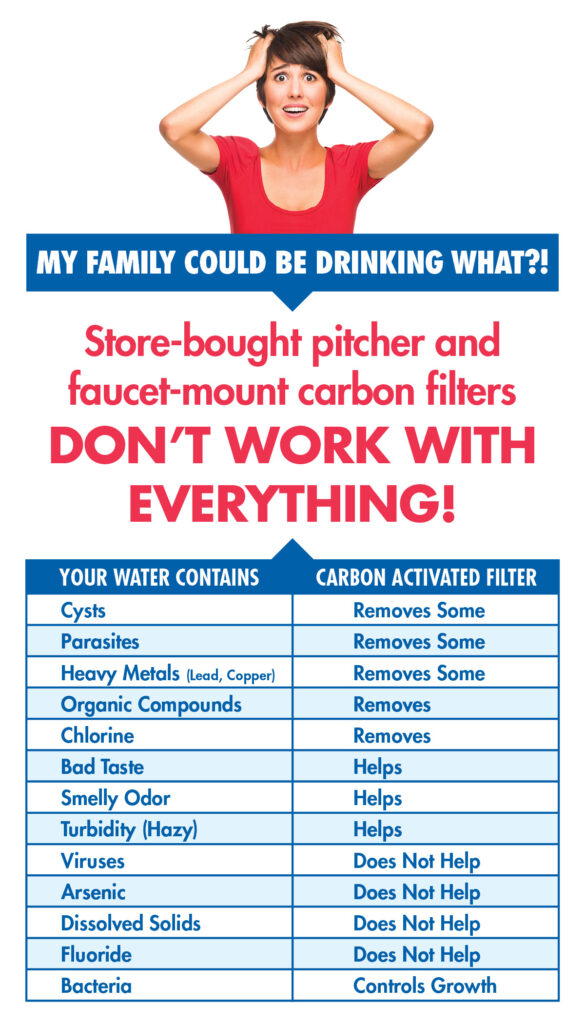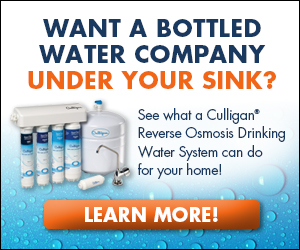The Benefits of Reverse Osmosis Vs Bottled Water
The popularity of bottled water has been increasing for the past decade, and it often ranks right behind soda as the most popular beverage across the country. As a nation, we also spend a lot (nearly $15 billion annually) on bottles of water. And while bottled water may be commonplace in our lives, it doesn’t always mean it’s the best choice for our health, or our wallets. So is it worth looking into alternatives like reverse osmosis (RO)?
The most commonly cited benefit of RO water is convenience. They can be installed under your sink, out of sight. You can access RO filtered water straight from the tap. There’s no running out to the store for more water, and there’s no waste from plastic bottles.
So who wins on taste, RO or bottled water? Well…bottled water can actually be RO water. As of publishing, many major bottled water companies run their water through a filtration process that includes reverse osmosis — including Dasani, Nestle and Aquafina. But bottled water taste can differ from brand to brand, and tap water – even with RO filtration – can taste different depending on location.
Still, there are many differences, and reasons why you might want to substitute bottled water for a home reverse osmosis filtration system.
What is Reverse Osmosis Filtration?
At Culligan, reverse osmosis works by passing water through a multi-stage filtration system, including a semi-permeable membrane. This membrane only allows particles of certain sizes through, so common water contaminants, and many not-so-common water contaminants, are removed from water. What you’re left with is purer, better tasting water — without additives or contaminants like chlorine, arsenic, lead, and others. Not only does reverse osmosis help improve the safety of water by eliminating potentially harmful contaminants from the water (things like lead that can make us sick); it also improves the taste of water, which can have a cascading effect of health benefits.
Reverse Osmosis Water vs. Mineral Water
Mineral water and RO water are somewhat polar opposites of each other — however, mineral water still usually goes through a purification process. So how is this possible?
Mineral water has a higher mineral content than regular tap water, whereas reverse osmosis removes many of the natural (and synthetic) minerals, additives and contaminants groundwater collects before making it through to your tap. However, most mineral water brands run their products through a filtration process before synthetically adding the minerals back in. While reverse osmosis mitigates the number of total dissolved solids in your water, mineral water actually requires at least a TDS count of 250 parts per million to qualify as such.
The appeal of mineral water to consumers is its taste, which to some, is more flavorful than reverse osmosis water, which has had many of its minerals stripped out of it. It all comes down to a matter of flavor preference. Regardless, you are drinking water that has been purified by filtration — often reverse osmosis.
The Differences Between Bottled Water and Reverse Osmosis
So what’s the difference between the bottled water you’re used to and reverse osmosis water?
The short answer is taste and consistency.
When it comes to bottled water taste, there is very little in the way of standards for bottled water. This is partly due to the variations available (artesian water, mineral water, drinking water) which are all regulated just a bit differently, and don’t generally have regulation for taste. As a result, it’s always a bit of a gamble what you’ll actually be drinking, and how it will taste, with bottled water from the store. You can generally count on it being safe, but the taste and quality can vary wildly from one brand and bottled water type to another.
Reverse osmosis water, by comparison, always has a consistent taste and quality. The filtration system is calibrated for your specific home’s water, so it removes the impurities that can lead to unpleasant taste and odor, leaving you with great tasting water that’s as dependable as your tap.
Benefits of Reverse Osmosis Drinking Water Systems

Reverse Osmosis water systems from Culligan can be installed at your sink and, depending on the model, they can be completely hidden so all you see on the counter is a button (as in the ClearLink Pro.) Once installed, you can access as much RO filtered water as you need, as often as you like. There’s no running out to the store for more water, and there’s no waste from plastic bottles.
Some additional things to consider when relying on bottled water:
- Plastic: Plastic has come under increasing scrutiny for many reasons, not the least of which is its impact on the environment and our health. Plastic water bottles contain materials that can leach into the water stored in them, and the odds of this increase with time and environmental factors, like heat. Plastic bottles are also one of the leading contributors to waste, as many of them are not recycled properly and eventually end up in landfills or our waterways and oceans.
- Cost: Bottled water can also be costly, especially if you have a larger household or you’re providing water for more than a few people. The bottled water price tag can add up to a significant monthly expense. All else being equal, a water filtration system will generally be more cost effective, and could even end up saving you money.
- Convenience: If you rely on bottled water, that typically means you have to purchase it, transport it, and store it. This often translates into more cost (gas, time, etc.) in addition to the waste. With reverse osmosis, there’s only a periodic maintenance, which can be automatically scheduled, so you don’t even have to think about that!

